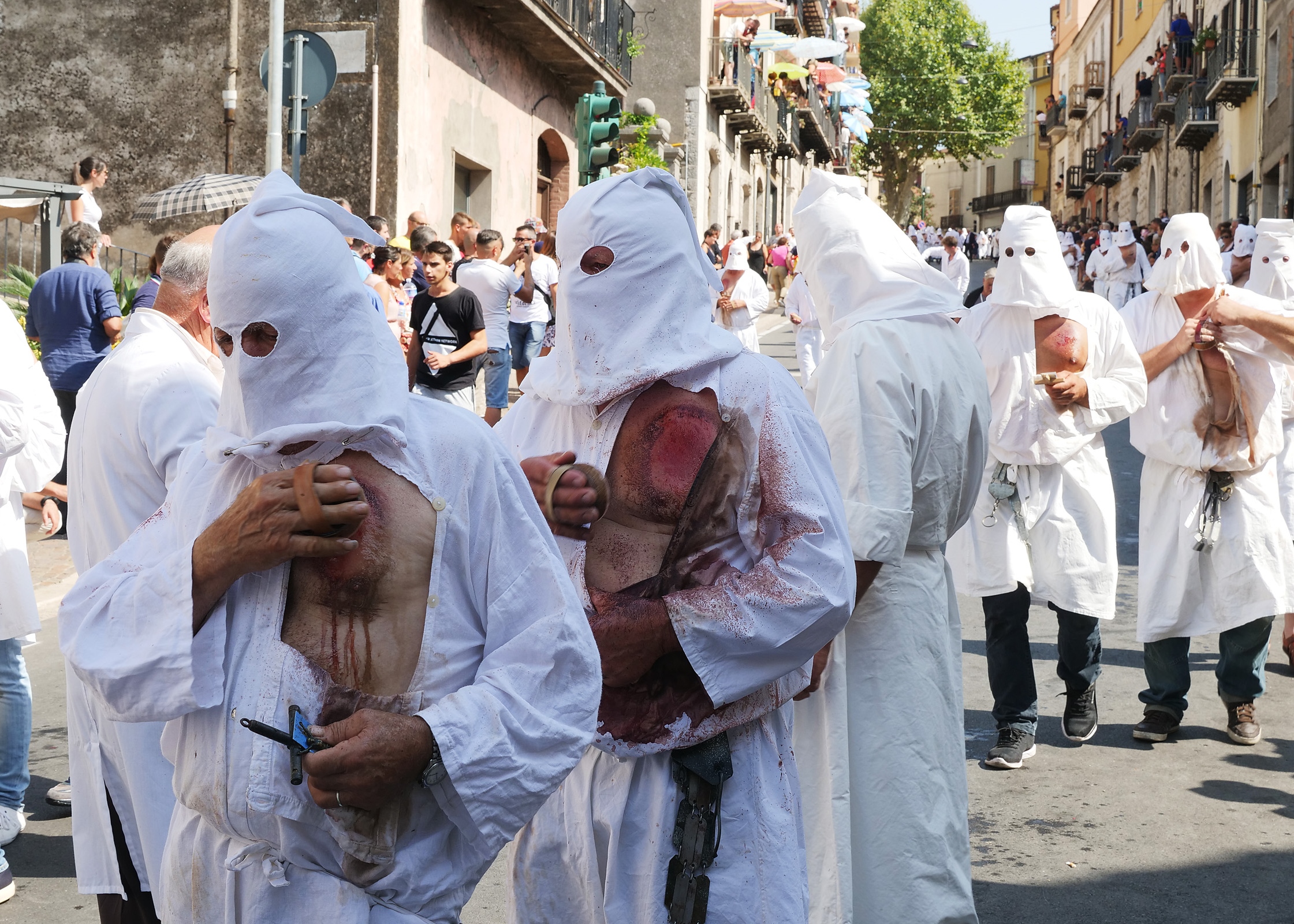
 Federazione Italiana Tradizioni Popolari
Federazione Italiana Tradizioni Popolari
Italian traditions: Winter Lights. Water, Wine and Blood in the folkloristic cultures of Southern Italy
- WTI Magazine #100 Feb 17, 2018
-

 Federazione Italiana Tradizioni Popolari
Federazione Italiana Tradizioni Popolari
"In the name of the Assumption, / brothers, beat yourself": to this invitation, pronounced with a stony voice by the Capo dei battenti, hundreds and hundreds of devotees kneel down on the churchyard, the chest begins to be struck with blood, while the painting of the Madonna leaves the church of Guardia Sanframondi, Sannio, in the Province of Benevento.
It seems to be an "archaic" ritual and therefore destined to disappear rapidly, because it can be confined to increasingly narrow areas, precisely because of closely related to a distant past. But direct observation - which is always the test bench on which to verify our ideological statements - will disprove this easy prediction.
Over the years I followed the seven-year deadlines, noting that as time goes by, the number of the battenti is growing more and more: 600, 900, over 1000, 1500. Not only elderly persons or adults, battenti by family tradition and belonging to subordinate classes, but also young people, often graduates or university students, who approach this ritual with a mixture of attraction and curiosity. The feast will increasingly be the subject of interest of curious journalists, scholars and scholars.
Blood poses itself as a symbol of belonging to an identity - it is "the community of us, i battenti" that is constituted, as an organ of the Guard Society, begging the Divinity to send water to the earth, essential for the local wine economy. Water, wine and blood constitute a triad that can be found in numerous rituals, even outside Europe, considered to be able to impress the rain. Sanframondi Guard battenti may be assimilated to the flagellants of Nocera Tirinese in the Holy Week in Calabria, more precisely in Lamezia Terme and in Verbicaro, in the province of Cosenza.
We can find blood, as a figure of identity and its further strengthening, in an even more emphatic form in the cult of San Gennaro in Naples, in which the entire population from Naples and from the Campania Region recognizes itself and its symbolic existence. The "miracle" of the liquefaction of blood takes place on three occasions a year; but there is also the liquefaction of the blood of St. Patrizia, the second Patroness of Naples, guarded by the Crucified Sisters in the convent adjacent to the church of St. Gregorio Armeno.
On August 25th of every year, the blood, considered to be holy and enclosed in a silver ampoule of precious craftsmanship, melts. During a mass celebrated in his honor it is shown to the faithful who flock from every part of Italy and also from other countries, as it happens in the already mentioned celebrations of San Gennaro. Besides on August, her feast day, the blood of Saint Patrizia, dry and adhering to the glass walls, melts every Tuesday at 11:00 am. It is a precise appointment that, as the Sisters have told us, it is never disregarded, even if they clarify that the true miracle is the works of charity to which they dedicate themselves with true missionary spirit.
The blood of San Gennaro has attracted the interest of philosophers and scholars such as Benedetto Croce (according to Croce the dissolution of the blood takes place for the first time on August 17, 1389), of writers such as Alexandre Dumas and Matilde Serao, who asserts, among other things, that "some of the blood of the Saint was taken to Madrid by Charles III who removed him from the second little ampoule in Naples before he came back to Spain". According to the Neapolitan writer, in the church of Madrid the blood melts in May and September, at the same time when the phenomenon occurs in Naples: but there's no confirmation of this statement.
Cinema directors have also turned their attention to the cult of San Gennaro: as an example we will remember the film by Dino Risi, Operazione San Gennaro. There has been attention in the anthropological field, too. Marino Niola, for example, pointed out that in the mid-seventeenth century a Dominican friar drew up a catalogue of "Sancti corps et insigni Reliquie" that are in the city of Naples. In it "the catalogued pieces are a few thousand, enumerated in sequences in which the sacred seems to disappear behind the comedian and grotesque. The only whole bodies are six hundred and a few hundred heads, the most noble of the relics. There are many ampoules and vials containing the blood of saints and blessed, surrounded by a particularly miraculous aura. If the supernatural automatism between relic and miracle is a strict sign and verification of the condition of holiness, the protection that the saints give to the city has its sacral seal in the blood, periodically glittering from the shrines'".
The scholar emphasizes that "in this climate of sacred wonders, the blood that bubbles and shines draws countless scarlet streams over the religious soul of the city: there are dozens of prodigious liquefactions that have in the miracle of the ancient Bishop and martyr their paradigmatic referent. Starting from the blood of Saint Giovanni Battista – which causes the exact effect caused by the blood of the glorious S. Gennaro - and of Saint Patrizia, up to that of Saints Lorenzo, Pantaleone, Andrea Avellino: now dry sources, with the exception of Patrizia.
Wine, too, is part of a vast symbolic scenario and is the object, in folkloric cultures, of deep ambivalence. On the one hand, it is particularly tasted and desired: in the southern regions, and not only there, taverns are one of the few centers of aggregation. On the other hand, the excess of wine is stigmatized as a vice and a sign of a man of little value: "drunkenness" is a term with a strong negative connotation, as negatively characterized is the proverbial expression of Calabrian "omu di vinu/non vali un carlinu" (a man of wine isn't worth a carlino – where a carlino is a pre-unitary coin).
It should be noted, however, that many Sicilian parables tell of a wine connected to the Sacred: for example, inexhaustible because placed on the tomb of a saint, clear testimony of its sacredness. This, moreover, is testified by the New Testamentary passages in which Christ identifies his body and blood in the bread and wine of the last dinner with his disciples, to whom the invitation is addressed to do the same in his memory and as his alter ego.
Countless beliefs and other demological documents testify to the vastness of the symbolic variegated scenarios to which the blood refers, and the documentation in this regard would be extremely easy: but what has already been written seems sufficient to underline the absolute centrality of blood in the folkloric horizon, and not only in it.
By Luigi M. Lombardi Satriani for "Il folklore d'Italia"